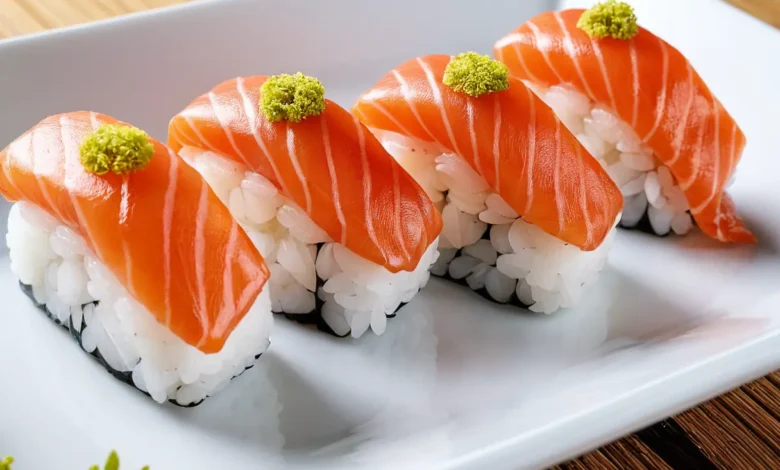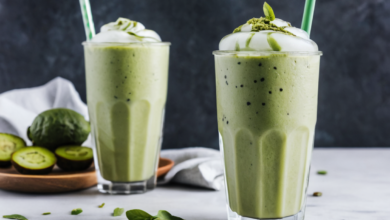The Art of Salmon Nigiri: A Simple Guide to Perfecting This Sushi Classic

Salmon nigiri is a beloved staple in the world of sushi, known for its exquisite flavor and delicate presentation. This simple yet elegant dish consists of a hand-formed mound of sushi rice topped with a luscious slice of fresh salmon. In this article, we’ll walk you through an easy-to-follow salmon nigiri recipe, explore the art of sushi making, and answer common questions about this delicious dish.
Why Choose Salmon Nigiri?
Salmon nigiri is not just delicious; it’s also packed with nutrients. Rich in omega-3 fatty acids, salmon offers numerous health benefits, including improved heart health and brain function. Plus, salmon’s buttery texture pairs perfectly with the vinegared sushi rice, making it a favorite among sushi lovers. Whether you’re hosting a sushi night at home or looking to impress guests, salmon nigiri is sure to be a hit.
Salmon Nigiri Recipe
Ingredients:
- For the Sushi Rice:
- 2 cups sushi rice
- 2 ½ cups water
- ¼ cup rice vinegar
- 2 tablespoons sugar
- 1 teaspoon salt
- For the Topping:
- 8 ounces fresh salmon fillet (sushi grade)
- Soy sauce (for serving)
- Wasabi (optional)
- Pickled ginger (optional)
Instructions:
- Prepare the Sushi Rice: Rinse the sushi rice under cold water until the water runs clear. This removes excess starch and prevents the rice from becoming gummy. Combine the rinsed rice and water in a rice cooker or pot and cook according to the rice cooker instructions or on the stovetop. Once cooked, let it sit for 10 minutes off the heat.
- Season the Rice: In a small saucepan, combine rice vinegar, sugar, and salt. Heat gently until the sugar dissolves, but do not let it boil. Transfer the cooked rice to a large bowl and gently fold in the vinegar mixture with a spatula or wooden spoon. Allow the rice to cool to room temperature.
- Prepare the Salmon: While the rice is cooling, slice the salmon fillet into thin pieces, approximately ¼ inch thick. For the best presentation, cut against the grain of the fish for a more tender bite.
- Form the Nigiri: Wet your hands with water to prevent sticking. Take a small handful of sushi rice (about 2 tablespoons) and gently shape it into an oval mound, pressing it lightly to hold its shape. Do not over-compress the rice, as it should remain fluffy.
- Assemble the Nigiri: Place a slice of salmon on top of each rice mound. If desired, you can use a small dab of wasabi between the rice and salmon for added flavor.
- Serve: Arrange the salmon nigiri on a plate and serve with soy sauce, pickled ginger, and extra wasabi on the side.
Tips for Perfect Salmon Nigiri
- Choose Quality Ingredients: Always use sushi-grade salmon to ensure freshness and safety. Visit a reputable fish market or grocery store that specializes in seafood.
- Practice Rice Technique: The key to great sushi rice is the perfect balance of vinegar, sugar, and salt. Adjust to your taste preferences for a custom flavor.
- Temperature Matters: Serve the salmon nigiri at room temperature. Cold salmon can dull the flavors, while warm rice enhances the overall experience.
- Garnish with Style: Consider garnishing your salmon nigiri with microgreens, sesame seeds, or thinly sliced scallions for an extra touch of flavor and elegance.
Frequently Asked Questions
1. Can I use other types of fish for nigiri?
Absolutely! While salmon is a popular choice, you can also use other sushi-grade fish like tuna, yellowtail, or even shrimp. Just ensure they are fresh and suitable for sushi.
2. How do I store leftover salmon nigiri?
Sushi is best enjoyed fresh, but if you have leftovers, store them in an airtight container in the refrigerator. Consume within 24 hours for the best quality.
3. Is it necessary to use sushi rice?
Yes, sushi rice has a unique sticky texture that holds together well, making it ideal for nigiri. Other types of rice may not provide the same results.
4. Can I make salmon nigiri without rice vinegar?
While rice vinegar is traditional for sushi rice, you can use apple cider vinegar or white vinegar as a substitute, though the flavor may differ slightly.
5. How do I know if my salmon is sushi grade?
Sushi-grade salmon should be fresh, bright in color, and free of any off-putting odors. It’s best to purchase from reputable fish markets or trusted suppliers who label their fish as sushi-grade.
Conclusion
Making salmon nigiri at home is easier than you might think! With a few simple ingredients and some practice, you can create this delicious and visually appealing dish that will impress your family and friends. Whether you’re enjoying a quiet evening at home or hosting a sushi party, salmon nigiri is a delightful treat that brings a taste of Japan right to your kitchen. So roll up your sleeves, gather your ingredients, and get ready to enjoy the art of sushi making!





